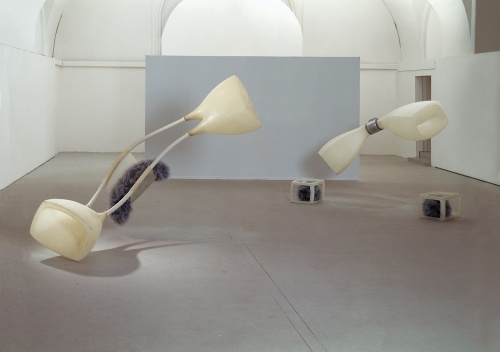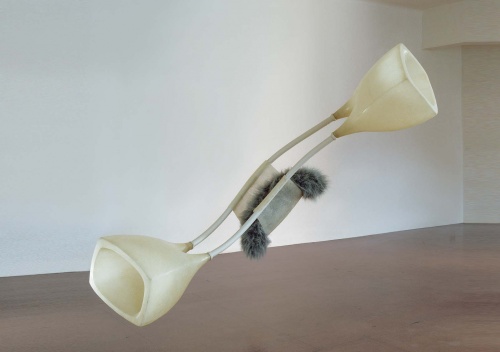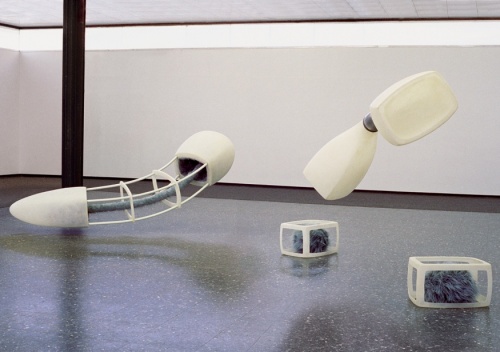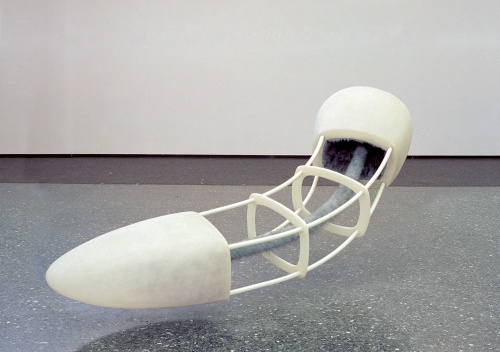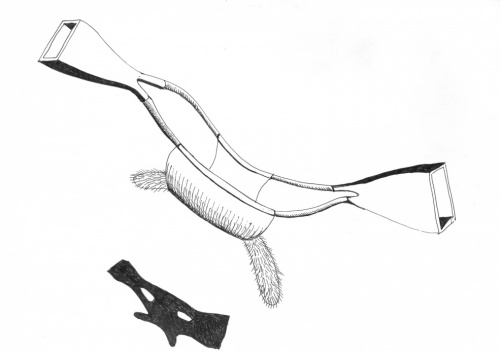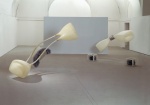 Sweet Lullaby (left), Transformator (right), Museumsquartier Vienna, 2001
Sweet Lullaby (left), Transformator (right), Museumsquartier Vienna, 2001
Photo: Günter Derp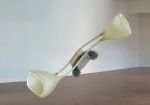 Sweet Lullaby, 2000; fibre glass, aluminium, foam rubber; 200 x 300 x 70 cm
Sweet Lullaby, 2000; fibre glass, aluminium, foam rubber; 200 x 300 x 70 cm
Courtesy: Lentos, Linz; Photo: Heinz Grosskopf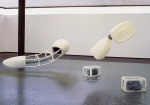 Oops (left), Transformator (right), Kunstverein Mannheim 2002
Oops (left), Transformator (right), Kunstverein Mannheim 2002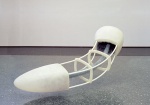 Oops, 2002; fibre glass, silicone, foam rubber, plush; 300 x 50 x 70 cm
Oops, 2002; fibre glass, silicone, foam rubber, plush; 300 x 50 x 70 cm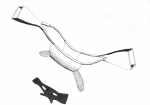 O.T., 2002, ink pen on paper; 21 x 30 cm
O.T., 2002, ink pen on paper; 21 x 30 cm
Sweet Lullaby
, Museumsquartier Vienna, 2001, Kunstverein Mannheim, 2002
...
"Sweet Lullaby …" also embodies those mysterious laws. Two monitors – connected by means of tubes resembling umbilical cords – cradle a furry creature in a small basket. However, the sculpture has no secure ground below it. It drifts in the space and thus underlines the dreamlike and nightmarish qualities that are alluded to so ironically in the title. At the same time it might recall Goya’s famous etching "The Dream of Reason Produces Monsters", transforming it into the third millennium. Instead of following suit to the horrific images and demonic masks, presented by Goya with Enlightenment fervor, Julie Hayward directs our attention to the subtle terror of the consciousness industry and the manipulative strategies in the virtual age. A sweet lullaby is being sung. However, one does not know whether the hairy larva will prove to be anything other than a Tamagotchi which is kept alive through digital love and care. Or does it carry a virus that spells danger?
Julie Hayward’s objects offer surfaces for projections that deploy an allusive logic. Precisely because they radically dispense with all imagery that has been fed in, be it photographic, film or video material – in spite of all the monitors and screens –, they are able to function as a sort of black box for our imagination. Here one has dreams in site/time/space that flow between various dimensions, triggering an exchange between external and inner imagery and sometimes even relating a continuous story. The "Transformator", for instance, shows how the cuddly plush creature in the cradle is suddenly cut in two and locked up in two cube-shaped enclosures. Is it the "iron cage" of rationality, as Max Weber described the prison of western consciousness? Or is it an enclosure designed for dangerous organisms in a high-tech lab?
Cage and grid structures are in any case part of Julie Hayward’s fixed formal repertory. In "Oops" they create the construction for a phallus-like structure that hangs ominously in the room with its mysterious power in statu erectionis; the flippant title alludes to something both surprising and embarrassing. The sexual dimension figures ambiguously in Hayward’s works – often only subtly, then more pronounced – when enormous phalluses dominate in the sculptures, and finally explicitly in a work that has been titled "Sublimator".
(...)
Even with all their irony and also humor, Julie Hayward’s sculptures do not just boil down to a shallow illustration of psychoanalytic, biotechnical, media theoretical discourses. They are open enough to create links with still unconscious manifestations of reality. They might be sensors for the future, as Walter Benjamin once noted in connection with his theses on the artwork: "To make mankind familiar with certain images before the ends for which the same images are being made have entered into consciousness."
...
cited from
Coming Home or: Arriving on Foreign Shores
Andreas Höll
read entire text
